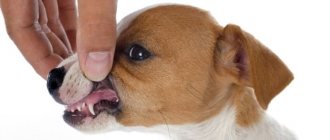Breeding a breed is a responsible and painstaking task that involves you in all aspects of the life of a particular animal. To get good results, breeders need to know how long pregnancy lasts in dogs, how it progresses, and what care the bitch needs. The expectant mother will need the help and support of the owner at every stage of pregnancy. Left unattended, it may not be able to withstand the load and suffer from complications.
How to tell if a dog is pregnant or not
The first symptoms of pregnancy in dogs can be noticed approximately 10-14 days after mating. In most cases, you will notice the following signs:
Happy mom
- loss of appetite. The animal may refuse food completely or eat less than usual. This phenomenon is explained by hormonal changes in the body, gradually appetite will be restored;
- nausea and/or vomiting. These are signs of toxicosis, which are also caused by changes in the endocrine system. No special actions are required from the owner; it is enough to provide the dog with access to clean water. Manifestations of toxicosis disappear around the end of the first month of pregnancy. If they continue, and especially intensify, then you need to consult a specialist to prevent intoxication;
- changes in behavior. They manifest themselves in different ways: some bitches become more affectionate, others fall into drowsiness and apathy, in others sensitivity may become aggravated, they do not allow themselves to be touched;
- nipple changes. Swelling and darkening of the nipples in early pregnancy in dogs is observed among those that have already been whelped. In firstborns, this process usually occurs later.
You can check whether your dog is pregnant or not at a veterinary clinic. If you are expecting offspring, a laboratory blood test will show increased levels of relaxin. However, this test is reliable only after at least two weeks have passed since the mating.
An ultrasound will also help determine the presence of embryos. Already at the beginning of the fourth week, the veterinarian will be able to record heartbeats. At a later date, for example, at the 6th week, the specialist will accurately determine not only the number of puppies, but also their level of physical development.
Visit to the veterinarian
After detecting the listed signs, make an appointment with a veterinary clinic. Plan a visit no earlier than a month after mating. By this time, relaxin, a sex hormone, will appear in the blood of the expectant mother, on the basis of which an interesting position is confirmed.
Determining the number of fruits
In addition to examination, palpation and blood tests, diagnosis involves ultrasound and x-rays. These procedures help determine the exact number and condition of the fruits, but not earlier than the beginning of the 2nd month.
Exclusion of pathologies
A visit to the veterinary clinic is recommended even if your four-legged pet is in good health. Not all pathologies are determined visually. Diagnostic procedures help to detect hidden complications and prevent their development.
Duration and characteristics of pregnancy in different dogs
Puppy in the womb
How long pregnancy lasts in dogs depends on the physiological characteristics of the animal. On average, the duration of the gestation period is 8-10 weeks (56-70 days). In the presence of pathologies (injuries, physical exhaustion, stress, illness) or due to age, labor may begin earlier or later than the specified interval. Knowing this, the owner should prepare in advance for possible complications.
The pregnancy of small dogs lasts about 60 days, and large breeds can give birth after 67-70 days, and for them this will be the norm. If more than 70 days have passed and the dog has not yet whelped, then you need to consult a veterinarian. Such a delay may be due to confusion in the timing, but it may also indicate the development of any deviations.
The number of puppies in the litter also depends on the size of the breed. According to statistics, a large dog has fewer of them than a small dog. The development of complications during pregnancy is not affected by the number of newborns or the size of the mother. However, post-gestation of the fetuses is of great importance - the puppies outgrow, and this makes childbirth difficult for the mother, and for newborns it results in hypoxia and intoxication. The early birth of offspring threatens babies with problems with the respiratory system.
How to determine pregnancy
It is recommended to show the bitch to a veterinarian 25-35 days after fertilization. During this period, the following diagnostic methods are most effective:
- Palpation . By palpation, pregnancy can be determined between 21 and 35 days. The veterinarian can feel the individual sacs of fluid in which the embryos develop. At later stages, the uterus becomes more flexible, and the sacs cannot be felt.
- Ultrasound of the abdominal cavity . An ultrasound examination 100% confirms pregnancy, establishes its duration, and determines the viability of the fetus.
- Hormonal test . To confirm pregnancy with a hormonal test, it is performed at 30 days or later. Testing earlier may show a false negative result.
Another diagnostic test is radiography. This is an effective way to determine the number of puppies. It is carried out from 42 to 55 days after mating.
Pregnancy periods in dogs
You can navigate by the timing of your pet’s pregnancy using a special calendar. It is compiled by days of gestation or by weeks. The last option is presented in the table below.
A week
Changes taking place
1
Egg division, embryo formation. There may be no changes in the dog's behavior.
2
The placenta is formed and the embryos are attached to the uterus. The animal loses interest in dogs, food, and sleeps a lot. Changes in the nipples are possible (a brighter color appears, the skin around them becomes rougher).
3
Future offspring can be seen during ultrasound examination. The content of relaxin in the blood is increased. At this time, toxicosis begins.
4
You can already feel the puppies with your fingers. Their bones form, antennae and eyelashes begin to grow. The expectant mother returns to her original state: she becomes cheerful, eats well, and vomiting and nausea disappear.
5-7
Organs of all systems grow and are finally formed, bone tissue becomes stronger, and fur grows back. It is during this period that a sharp increase in the dog’s body weight occurs. By the end of the 7th week, she becomes more careful, moves less, and protects her stomach.
8
The pet's mammary glands are completely ready for feeding; colostrum may leak from them. The puppies become cramped, they move actively, which is noticeable to the naked eye. Due to prolapse of the uterus, the abdomen is located very low.
8+
You need to be prepared for labor; it can start at any time. The bitch's temperature should be measured three times a day. A sharp drop indicates that labor will occur within 24 hours.
Signs and symptoms of pregnancy
Beginning breeders strive to look for some changes in the pet’s behavior and well-being immediately after mating. For a veterinarian or a more experienced owner, it is obvious that the first signs of an “interesting situation” will appear only after 3 weeks .
Changes indicating pregnancy include:
- Mild apathy. The dog becomes less active and spends less time playing and active walks;
- Drowsiness, previously not characteristic of the bitch;
- Phlegmatic traits appear in the character.
But even these signs are only indirect confirmation of pregnancy. A more accurate result can be obtained thanks to:
- A test performed that shows changes in hormonal levels;
- Appearing toxicosis. It clearly manifests itself in the morning and lasts, on average, no more than 7-10 days . Soft food, which the dog receives in small portions, will somewhat alleviate this unpleasant condition;
- Swelling of the mammary glands and a change in their shade is noted at the end of the 4th week after mating.
Experienced breeders also focus on secondary signs that confirm successful mating:
- Increased appetite. The animal actively absorbs food, and this also applies to those whom the owners considered “little ones”;
- Increase in waist size. This can be seen with the naked eye. It is ideal if, after mating, the breeder measures the pet’s waist circumference. Comparing the data after 3.5-4 weeks, you can see the difference between the two indicators;
- Character changes. Some dogs become more withdrawn and react aggressively to others;
- After 40-45 days, the fruits can already be carefully palpated.
Careful monitoring of the condition of his dog will allow the owner to identify the onset of pregnancy by changes in the condition and character of the pet better than the most experienced veterinarian who sees the dog for the first time in its life.
Pay attention to our article: False pregnancy in dogs - what to do and how to treat?
How to care for a pregnant dog
Proper care of the dog will be required not only after mating, but also 2-3 months before it. The four-legged friend will need to be shown to a veterinarian to rule out contraindications for pregnancy, discuss possible vaccinations (including those that fall out during pregnancy), be tested for various infections, and undergo anthelmintic therapy.
After pregnancy has occurred, the owner needs to pay special attention to the physical activity, nutrition and hygiene of the animal. In addition, the upcoming addition to the family will require the owner to make some changes in the house.
Walks
In the early stages of pregnancy, you should not protect your dog from long walks. A sufficient amount of oxygen will reduce the manifestations of toxicosis during its development, and will also have a positive effect on appetite and the development of offspring. However, there is no need to force an animal to engage in physical activity. If the pet is lethargic, wants to sleep, and turns to go home, then it is better to take it for a walk more often, but not for long.
Nutrition
Food should be high in calories within reasonable limits. The guideline is the dog’s appearance: with obvious weight loss, the calorie content of the diet is increased and vice versa. Toxicosis should also be taken into account - it can cause the animal to lose weight. It is necessary to add more protein foods to the diet, and reduce foods containing carbohydrates. In the second month of pregnancy, excess carbohydrates and fats can trigger the development of obesity, which can lead to problematic childbirth.
A pregnant dog requires extra attention
If your dog prefers dry food, you should choose a product specifically designed for this period. Don't forget about vitamin and mineral supplements. With natural nutrition, they are added to food or given separately from food.
Attention: dry food for pregnant dogs, as a rule, already contains the necessary components; information about their quantity can be found on the packaging. Excess vitamins can harm both the expectant mother and the puppies.
In the first month of pregnancy, the diet remains the same - twice a day. Subsequently, the frequency of meals is increased to 3, and then to 4 times a day. Small meals allow for more complete absorption of food and prevent stagnation in the intestines, since growing puppies put pressure on the stomach and interfere with the normal movement of food through the digestive tract.
Hygiene
Hygiene procedures include washing paws after a walk and regular treatment of eyes and ears. Experts do not recommend bathing a dog during pregnancy and lactation. This can only be done if absolutely necessary. The owner must ensure that the animal is not exposed to a draft: the fur must be dried as quickly as possible.
Changes in the house
The owner will have to make changes to the interior in the second half of the pet’s pregnancy. By this time, the dog’s body weight increases, it becomes less active, and rests more. To make her comfortable, you need to make a new, larger bedding.
Closer to birth, the animal looks for a suitable place for this. It is advisable for the owner to select a secluded corner in advance, equip it accordingly, and then gradually accustom the animal to it. Sometimes the dog itself determines the desired territory and does not want to change it to another. In this case, you will have to make concessions (within reason).
The room in which the newborn puppies and mother will be located should not be too cold or too hot. Optimal conditions: average air temperature, absence of drafts, ability to move. At first, the corner needs to be fenced off from the rest of the space in such a way that the puppies cannot leave it, and the adult animal can easily pass back and forth.
Signs of an interesting situation
It is quite difficult to guess that a pet is carrying puppies in the early stages. At first, only behavioral changes are noted that are noticeable to attentive owners. The expectant mother becomes inactive and refuses long walks. She gets nervous in noisy companies and tries to find a secluded place. Her appetite increases or decreases sharply, and she often vomits in the morning.
After detecting these symptoms, be sure to visit a veterinary clinic. More obvious signs appear only a month after fertilization. A pregnant woman's belly becomes rounded and enlarged. Viscous mucus is released from her loop, and the nipples swell.
By the end of 2 months, babies can be palpated, but this is recommended only under the supervision of a veterinarian. Fragile fruits are easy to injure, so avoid self-examination.
Pathologies of pregnancy in dogs
The pathological course of pregnancy in dogs can be caused by many factors:
- diseases;
- helminthiasis;
- abnormalities of internal organs;
- age characteristics;
- stress;
- incompatibility with a male dog.
Such pathologies include false, frozen and ectopic pregnancy.
False pregnancy in dogs
6-8 weeks after estrus, your dog may show signs of a false pregnancy:
- increased appetite and thirst;
- swelling of the nipples, appearance of colostrum;
- nausea and vomiting;
- apathy, drowsiness.
During a false pregnancy, dogs may show increased interest in soft toys.
A pet may show increased interest in soft toys, “caring” for them.
False pregnancy poses a certain danger to the physical and mental health of the dog. Among its consequences are tumors of the mammary glands, cancer of the appendages and uterus, infectious diseases of the genitourinary organs, and mental disorders. If the animal exhibits the above symptoms, the owner should take the bitch to the clinic for an ultrasound as soon as possible.
Treatment of false pregnancy at the beginning of the development of pathology consists of changing the dog’s living conditions. The frequency of feedings is reduced to once a day, while significantly limiting liquid, dairy and meat dishes. All objects that remind the dog of its “motherhood” must be removed. The amount of time allotted for a walk is increased to the maximum possible, trying to stimulate the pet's physical activity in all available ways.
If after 3-4 days the situation has not changed, and even more so has become more serious, they begin drug treatment. Hormone-based medications and homeopathic remedies are indicated as therapy. If there is no result, surgery is performed.
Frozen pregnancy in dogs
This pathology is characterized by the death of embryos (all or partially). Stopping the development of embryos can occur for various reasons. What to do in this case depends on how the dog’s body reacts to what happened.
- If all embryos die, you should wait until a miscarriage occurs. If you wait for a long time, it is stimulated artificially, since frozen embryos can mummify and begin to decompose.
- If live embryos are preserved (ultrasound is required), the pregnancy is preserved. During childbirth, the dead embryos will be released along with the newborns. After birth, a control ultrasound examination of the animal is carried out: if there are dead remains in the uterine cavity, they are disposed of by stimulating contraction of the walls of the organ. If there is no result, the dog is sterilized.
There are other options for the development of events. For example, a partial miscarriage of dead embryos may occur with the preservation of normal or all embryos (both dead and living), purulent inflammation may begin or there will be no symptoms at all, and so on. The owner must be extremely attentive to the dog and contact the clinic at the slightest change in the animal’s condition.
Ectopic pregnancy in dogs
Ectopic pregnancies can also occur in dogs. It occurs due to various reasons: pathological structure of the uterus, trauma, endocrine disorders. The first signs are bloody discharge and pain (the animal may whine). Such a pregnancy is most often terminated with the help of medications, if the period is short, or surgically.
Possible complications
If you notice any alarming symptoms, including a significant deviation from the planned date, call your veterinary clinic immediately. It is better to be wrong in your guesses than to allow the death of your four-legged pet and her babies.
Ectopic pregnancy
The development of embryos outside the uterus is fraught with death due to internal ruptures and bleeding. It is accompanied by pain and bloody discharge from the uterus. If the animal whines and blood flows from its loop, call a doctor.
False pupishness
False whelping, or false pregnancy, can be easily determined independently only by the absence of mating. This condition is accompanied by similar symptoms, but instead of labor, it can result in mastitis or other complications. Due to the likelihood of such an outcome, veterinarians recommend not to refuse blood donation, ultrasound and x-rays.
Frozen pregnancy
Partial or complete death of embryos is fraught with mummification with subsequent intoxication of the body. If the dead fetuses do not come out on their own, they are removed by artificial stimulation of the uterus or by sterilization.
If the dog paces
A delay of more than 10 days is an alarm bell. In addition to the death of the fetus, the reason may lie in a delay in its development, pathologies of the genital organs of the bitch, or other diseases of the four-legged woman in labor. Healthy babies are removed by caesarean section.
Vaccinations during dog pregnancy and lactation: possible or not
Pregnant and lactating dogs are not vaccinated. Vaccines can cause serious harm to developing puppies, ranging from developmental abnormalities to fetal death. Vaccinations must be given before mating. The animal’s passport will help determine the due date: the owner must look at the date of the next vaccination and compare it with the duration of the upcoming pregnancy and lactation. If they match, you need to contact a veterinarian and get vaccinations either before mating or after the expected lactation.
Week six (35-42 days)
The female's belly increases greatly in size, and now her pregnancy is an obvious fact for everyone. Every day it will grow. Changes also occur in the female’s body: the nipples become larger, their shade changes - it becomes darker.
During this phase, puppies begin to develop their individual characteristics. Skin pigmentation determines coat color. On days 35-39, fetal growth is 3.5 cm, by the 40th day it increases to 5 centimeters.
The number of feedings of the female increases, but if the dog wants to eat, you should not refuse it. At the same time, overfeeding and excessive weight gain should be avoided. A smart step would be to include multivitamins and special food for puppies in the menu, but only a veterinarian can say what exactly will be beneficial for your dog.
The owner can already prepare in advance the place where the dog will give birth. It should be warm and comfortable. Expectant mothers need to be gradually prepared for a cozy place, and her desire to relax in it should be encouraged.
Termination of pregnancy in dogs
In some cases, it becomes necessary to terminate pregnancy in dogs. This can happen due to medical indications, for example, due to an ectopic pregnancy, or the mating was not planned. The sooner the interruption is made, the greater the chance that the animal will retain the ability to conceive again. Surgical abortion often results in complete sterilization.
Medical abortion is performed using hormonal drugs, such as mesalin. Injections are given twice, and if necessary, three times every other day.
Important: dog owners need to know that such intervention entails disturbances in the functioning of the endocrine system, dysfunction of the gonads, inflammatory processes in the uterus, and abnormal course of subsequent pregnancies.
How to terminate a pregnancy
In some cases, it is necessary to resort to post-coital contraception and induced abortion. This is a responsible step on which the life and health of your pet depends. How to do this so as not to harm the dog's health?
Reasons for termination of pregnancy
- Unplanned (accidental) mating.
- Mating during the first heat of a young female.
- Disproportions in the sizes of males and females.
- Ectopic pregnancy.
- Dog health problems.
- Possible problems with offspring due to pathologies in the structure of the dog’s pelvis.
The sooner the termination is made, the greater the chance of maintaining the dog’s ability to have offspring. In veterinary medicine, two methods of ending pregnancy are used: medication and surgery. Both methods cause serious damage to the dog's health. They are recommended to be used only for serious medical reasons .
Medication method
This is a more gentle way. In veterinary medicine, injectable drugs and tablets are used. The choice of drug for induced abortion depends on the stage of pregnancy and the health of the dog.
Veterinarians use:
- Estrogen-based drugs. Used at the beginning of pregnancy. They have serious side effects: infertility, disruption of internal organs.
- Natural and synthetic analogues of prostaglandins. Used early. A more gentle way. Prescribed only after pregnancy is confirmed (ultrasound).
- Progesterone antagonists. Use up to 45 days after mating. They have contraindications and side effects.
- Corticosteroids. Used at a later date. Can cause serious complications, including death of the animal.
Important!
The decision to terminate is made only by a professional veterinarian. He will examine the animal, choose an acceptable method of termination and medications.
Last days before giving birth
You can find out that birth is approaching by looking at specific vaginal discharge from the animal. Most often, they appear after the dog wakes up or when urine is released. At this time, you need to monitor your body temperature. Approximately 20-24 hours before delivery, the temperature will drop by 1-1.5 degrees. In addition, a change in the pet’s behavior will also indicate the onset of labor: she begins to look for something, dig a “hole” in the floor. When the dog begins to sit down and fuss, you need to prepare to receive newborns - no more than an hour and a half remains before their appearance.
Pregnancy in a domestic dog should be under the constant supervision of the owner, who has first aid supplies on hand, as well as the phone number of a veterinarian. Attention and care are the key to successful pregnancy and birth of healthy puppies!
Fourth week (21-28 days)
A veterinarian and an experienced dog breeder can feel the fetus by palpating the abdomen. In embryos, the organs of vision develop, the muzzles take on their usual shape, and the spine becomes stronger. The fruit size is up to 1.5 centimeters in length.
In veterinary medicine, this period of pregnancy is considered the most important, since puppies are especially vulnerable to the development of abnormalities and damage. The dog must be limited in physical activity and physical activity. There is a need for nutritional correction; additional nutritional supplements are introduced into the diet.
The female's nipples become rough, and a small amount of clear fluid may be released from the vagina.
Eighth week (49-57 days)
During this period, the owner needs to be on alert, as puppies can be born at any minute. The bone tissue of puppies is already very strong, the teeth are formed, and their growth corresponds to the size of newborns. An ultrasound will accurately determine the number of fetuses.
Physical activity and stress accelerate this process, so it is necessary to surround the expectant mother with care and attention, make sure that she moves less and rests more. It is advisable for the puppies to stay in their mother's belly for a week. When the dog is lying down, you can feel the puppies to see how they move in the uterus.
The female begins to secrete colostrum from her nipples, which is a harbinger of childbirth. She worries, looks for a comfortable, quiet place for childbirth, lies most of the time, getting up only to eat and perform natural needs.
How puppies develop in the belly of a mother dog
Let's look at how babies develop while in the womb of a pregnant dog:
Photo: Jack Russell Terrier puppies | Dreamstime.com
- 1-2 weeks:
at the very beginning of pregnancy, embryos, covered with a protective bubble, make their way from the ovaries to the uterus, where they are fixed and grow; - 3-4 weeks:
Tiny embryos begin to form important internal organs, the nervous system and skeleton. The resemblance of ears, eyes, and nose is already noticeable on the head and muzzle. By the end of the 4th week of pregnancy, babies have antennae and eyelashes, and fur develops; - 5-6 weeks:
the embryos grow more and more actively, the bones become stronger. The primary sexual characteristics of male and female puppies are formed; - 7-8 weeks:
puppy teeth develop, fur appears on the face and belly. The internal organs are quite developed. By the end of 8 weeks, the puppies are practically formed and ready to see the world.
Seventh week (42-49 days)
The puppies develop safely and quickly; at this stage they are already fully formed.
The female sheds heavily, especially in the abdominal area. This is a normal physiological phenomenon and should not cause concern. In this way, the expectant mother’s body prepares for the birth of babies.
Complementary feeding with special food for puppies can be omitted, and the female can be transferred to the usual method of feeding, but the food must be nourishing, enriched with vitamins and nutrients.
Preparing for childbirth
About a week before the expected date of birth, you need to take care of a comfortable place for the “nest” in which the birth will take place and the puppies will be with their mother. The structure must be closed on 4 sides so that the animal feels calm and safe. The house must be positioned so that the owner and veterinarian can gain access to the mother and babies if necessary.
Be sure to prepare items that will be useful during the birth process and immediately after it. These include:
- Sterile bandages and gauze (to wipe babies);
- Absorbent or rubberized diaper (on the floor in the house);
- Iodine, brilliant green, cotton pads for treating the umbilical cord;
- Medical rubber “bulb” (to remove mucus from the puppy’s nose);
- Sterile scissors and threads (for tying and cutting the umbilical cord);
- Scales and a notebook to record information about the sequence of appearance and weight of the puppies;
- Multi-colored woolen threads (tie around the neck to distinguish the babies);
- formula for newborn pets and a heating pad, in case of complications of the mother’s condition or her reluctance to feed.
Detailed article on the topic: “Features of childbirth in a dog: preparation, symptoms, care.”
The length of time you wait for puppies depends not only on their number, but also on the size of the female, her age and how pregnant she is. By following the recommendations for caring for the mother, as well as observing her condition, you can monitor the development of the babies, as well as prepare everything necessary for their birth in time.
4.7 / 5 ( 3 voices)











